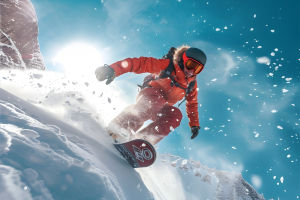Regular skiing isn’t just a fun winter activity, it’s a powerful way to significantly enhance your balance.
Skiing requires continuous adjustments to maintain stability, helping skiers improve their coordination, strengthen their muscles, and become more attuned to their body’s position in space.
This combination of physical engagement and mental focus makes skiing one of the best ways to work on balance. Here’s how regular skiing can make you more stable both on and off the slopes!
Engaging Core Muscles for Stability
One of the key aspects of skiing that works to improve balance is the continuous engagement of core muscles. While skiing, your body maintains dynamic movements and posture adjustments, which require constant activation of muscles around your torso.
These muscles, including the abdominals, obliques, and lower back, play a crucial role in stabilizing the body. The action of leaning forward or to the sides while controlling speed or making turns forces the core to contract and react swiftly, improving overall muscle coordination.
Proprioception: Understanding Body Position in Space
Proprioception refers to the body’s ability to sense its position in space and make adjustments without relying on vision. Skiing forces you to rely heavily on proprioception as you navigate diverse terrain and uneven snow conditions.
With each turn, jump, or mogul, your body’s sensors are working overtime to adjust balance in real-time. The more frequently you ski, the better your proprioceptive skills become, leading to faster reactions and better control of your body’s movements.
Improved Leg Strength and Stability
Strong legs are essential for maintaining balance, and skiing provides an excellent workout for building leg strength. Skiing not only strengthens major leg muscles such as the quadriceps, hamstrings, and calves, but also improves ankle stability. The frequent adjustments to ski angles, weight distribution, and pressure help train the lower body to stay steady and respond to shifting forces, which translates to improved balance both on and off the slopes.
Enhanced Flexibility and Joint Mobility
The variety of movements involved in skiing – from carving turns to absorbing terrain shifts – can increase flexibility and mobility in the joints. Skiers regularly push their knees, hips, and ankles to their range of motion limits, gradually improving the joint’s flexibility and overall function. Increased flexibility in these areas can directly translate to better balance control, as greater flexibility helps the body adapt more effectively to sudden changes in posture or balance challenges.
Mental Focus and Reaction Time
Skiing is not just a physical exercise but also a mental one. The focus required to navigate down slopes, especially in high-speed situations, helps sharpen cognitive reaction time. In skiing, quick adjustments and decisions are often made in split seconds to avoid obstacles or sudden shifts in terrain. Over time, your ability to react quickly and precisely to such changes enhances your overall balance, as it trains the brain to process environmental changes efficiently.
Practical Tips for Skiers to Improve Balance Further
For those looking to improve their balance through skiing, certain strategies can make the process more effective:
1. Practice balance drills off the slopes: Using a balance board or stability ball can help you strengthen the muscles involved in skiing.
2. Vary terrain types: Skiing on different types of snow, from powder to ice, challenges the body to adapt, improving balance in various conditions.
3. Take ski lessons: Even experienced skiers can benefit from the expertise of a coach who can refine techniques and help improve posture and movement patterns.
The blend of physical exertion, mental focus, and muscle engagement makes skiing an excellent exercise for anyone looking to improve balance. Regular skiing not only enhances core strength and stability but also hones proprioception, strengthens leg muscles, and boosts flexibility. Whether you’re a seasoned skier or a beginner, consistent skiing can provide substantial improvements to your balance, helping you feel more grounded in all aspects of daily life!


